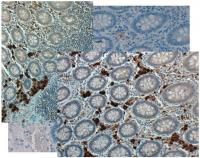GDF15 Rabbit Polyclonal Antibody
CAT#: TA319179
Rabbit polyclonal Nag-1 antibody Peroxidase Conjugated
Need it in bulk or conjugated?
Get a free quote
CNY 7,519.00
货期*
5周
规格
经常一起买 (2)
beta Actin Mouse Monoclonal Antibody, Clone OTI1, Loading Control
CNY 300.00
CNY 1,430.00
Specifications
| Product Data | |
| Applications | IHC, WB |
| Recommend Dilution | ELISA: 1:10,000-1:50,000, WB: 1:1,000-1:5,000, IHC: 1:500-1:2,500 |
| Reactivity | Human, Mouse |
| Host | Rabbit |
| Clonality | Polyclonal |
| Immunogen | Anti-NAG-1 (C-terminal specific) antibody was prepared by repeated immunizations with a synthetic peptide corresponding to a region near the carboxy terminal end of human NAG-1 protein. A residue of cysteine was added to facilitate coupling to KLH. |
| Formulation | 0.02 M Potassium Phosphate, 0.15 M Sodium Chloride, pH 7.2 |
| Concentration | lot specific |
| Conjugation | Peroxidase |
| Storage Condition | Store at -20°C as received. |
| Gene Name | growth differentiation factor 15 |
| Database Link | |
| Synonyms | GDF-15; MIC-1; MIC1; NAG-1; PDF; PLAB; PTGFB |
| Note | Non-steroidal anti-inflammatory drug (NSAID) activated gene (NAG-1) is a member of the transforming growth factor-beta (TGF-beta) superfamily. NAG-1 is also known as Macrophage Inhibitory Cytokine-1 (MIC-1), Growth Differentiation Factor 15 (GDF15), Placental Bone Morphogenetic Protein (PLAB), or Prostate Derived Factor (PDF). NAG-1 is expressed in human placenta, prostate and colon. It possesses antitumorigenic and proapoptotic activities. NAG-1 expression is dramatically increased in inflammation, injury and malignancy. Increase of NAG-1 expression is a feature of many cancers including breast, colon, pancreas and prostate. In a number of studies, NAG-1 expression was increased by a number of NSAIDs. This increase in expression may correlate with the chemopreventive effect NSAIDs seem to have with certain cancers. NAG-1 expression is also induced by PPAR gamma ligands and by several dietary compounds such as conjugated linoleic acids (CLAs), naturally occurring fatty acids in ruminant food products, indoles, epicatechin gallate, and genistein. Induced expression of NAG-1 results in stimulation of apoptosis and inhibition of cell growth. Inhibition of NAG-1 induced expression by small interference RNA (siRNA) results in repression of induced apoptosis. NAG-1 expression is regulated by a numbers of transcription factors such as ERG-1 and Sp1. EGR-1 may be necessary for NSAID-induced NAG-1 expression. The study of expression of NAG-1 proteins, including variants, is important to define their potential role as serum biomarkers for cancer diagnosis, treatment monitoring, epidemiology study, and nutrition surveys. |
| Reference Data | |
| Protein Families | Druggable Genome, Secreted Protein |
Documents
| Product Manuals |
| FAQs |
| SDS |
Resources
| 抗体相关资料 |
Customer
Reviews
Loading...


 United States
United States
 Germany
Germany
 Japan
Japan
 United Kingdom
United Kingdom
 China
China



